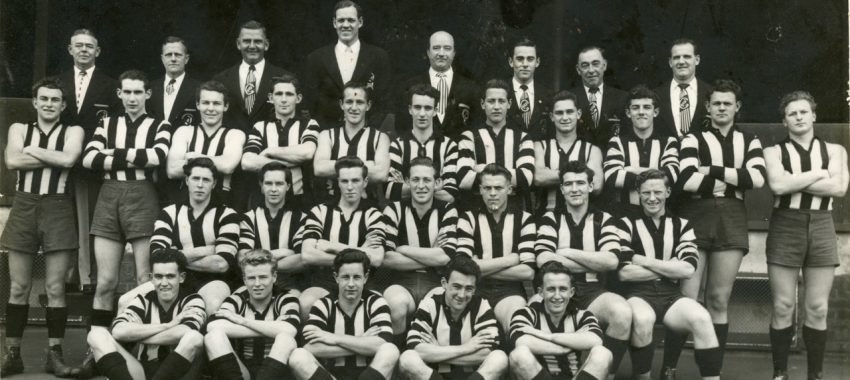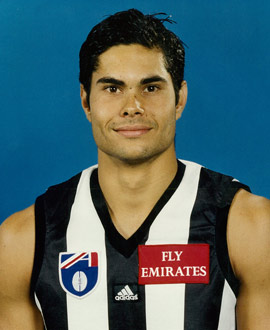By: Glenn McFarlane on 3 July 2014.
Take a look at the state of origin of Collingwood's 2014 list and it gives an indication of how AFL recruiting has changed over the generations.
Six Magpies were either born or raised in Queensland. That's a rarity for the Magpies, who like so many clubs have only embraced footballers from our most northern state in the last generation and a half.
Three of those players - Dayne Beams, Lachlan Keeffe and Josh Thomas - have been regular fixtures in the Collingwood team in recent seasons, while Ben Hudson, Adam Oxley and Peter Yagmoor have also played in stages.
Beams might well be the best Magpie footballer to have come from Queensland.
He's won a Copeland Trophy, played in a premiership side, and is a prolific ball winner and an elite footballer.
Gavin Crosisca would probably lay claims to the honour.
Australian football has been played in Queensland since the early 1860s, but there were few footballers from that state to break into the Victorian Football League, which would become the Australian Football League in 1990, for much of the 20th Century.
Col Kimmorley was one of the early Queenslanders to make his mark with Collingwood.
Frustratingly, it was not as big a mark as either the club or he would have liked.
Having played for his state in 1974 and '75, and with Queensland club Western Districts, Kimmorley came to Victoria Park at one of the most difficult periods in the club's history.
It was 1976, and the Magpies were hurtling towards their first wooden spoon in its long and proud history.
Kimmorley could hardly have felt secure in that environment, despite his potential. The 19-year-old would play four games that season- for four successive losses.
He never got to sing the club theme song after any of his four senior Collingwood games. He debuted against South Melbourne at Waverley Park. His one and only goal in black and white came in his second game against Hawthorn a week later.
Kimmorley's fourth and last game came against Geelong at Kardinia Park in Round 17 - a match best remembered for other happenings.
The club's reserves coach and chairman of selectors, Ron Richards, would cop a reprimand for using "rude" language to a boundary umpire during a half-time brawl between the players of both sides. That reprimand would have hurt Richards, but nowhere near as much as the police horse that stood on his foot "at the height of the commotion."
Kimmorley had 11 touches for the match, his best return from his four games. But he would never get the chance to add to that tally.
He would injure his knee, which would require a reconstruction, and his career at Collingwood was over. But he would eventually return to his home state and continue on his football career.
Then, in 1983-84, three Queensland recruits flashed across the Collingwood backdrop and were gone almost as quick.
Incredibly, all three of them represented the Magpies in one forgettable practice match against a Queensland state team in February 1984 - 30 years ago this year.
The match took place at a ground with a very familiar name, John Wren Oval, in Brisbane, named after the man who was a major Collingwood benefactor for much of his life, and who donated an oval bearing his name to the Brisbane City Council.
Collingwood had a less than memorable win that day, but it was the first time that the club would boast three Queensland playing in the same team for the club, even though it was only a practice game.
The first of those three players was Gary Shaw, who will go down as being one of the most expensive recruits in the Magpies' history.
As the New Magpies scoured the country for the best possible recruits, intent on chasing a premiership at any price, Shaw loomed as a player who was worth recruiting, despite the hefty price tag.
At a time when money was changing hands as if it was confetti, Shaw's transfer fees alone were more than $300,000 - the price of a half-dozen houses in some suburbs back then.
He had originally played for Western Districts before making his name as a star rover for Claremont across two seasons in a side that contained the Krakouer brothers. He had played in Claremont's 1981 premiership side, sharing the Simpson Medal for best afield with South Fremantle's Maurice Rioli.
Wearing the No.11, Shaw played the first seven games for Collingwood in 1983 before a shin stress-fracture ruined his season and he returned only for the final game of the season.
He performed better for the Magpies the following season, playing 19 games, including three finals, despite missing six weeks early in the year due to a bad hamstring tear. 1985 was a wipe-out, thanks to a groin year and his last season at Collingwood was 1986, and it yielded only eight games, with a shoulder dislocation costing him more than three months on the sidelines.
Shaw said at the time: "Every time I've started playing well, I've been hurt. I still think I'm good enough. All I want is a fair chance to prove it."
Sadly, he wouldn’t get that chance. When his stint at Collingwood was over, Shaw went back to Queensland where he tried to make his mark with the Brisbane Bears.
He signed a three-year deal with the Bears, but he would only manage six games for them.
Shaw's 32 games at Collingwood was more than another fellow Queenslander, Carl Herbert, who joined him at the club in 1983.
A rover, like Shaw, Herbert had been a Queensland representative at the age of 18 before he came to Victoria Park.
His first game came against Sydney in Round 9, and then he had 17 touches against Fitzroy the following week before a groin injury intervened. He would return for a third, and final, game in Round 22, against St Kilda. That day he would take to the field with Shaw in Black and White for the first time.
Herbert would later move to West Adelaide before returning to Mayne in Queensland, where he would captain the club and win best-and-fairest awards.
Dale Woodhall was already a prolific goal kicker in the Queensland league when Collingwood chased him at the end of the 1983 season. He had kicked 113 goals that season and the Magpies hoped he would be able to deliver similar hauls.
For a time, he promised more than a bit of hope. He was instantly promoted to the No.2 jumper and Magpie fans wondered if he might be the great full-forward hope they had waited for. Woodhall kicked two goals in each of his first two games.
Then, in round four, he kicked seven goals in the club's narrow seven-point loss to Sydney at Victoria Park. But that would be his finest moment.
He would kick 32 goals from his 12 games that season, but it was not enough. Like Herbert, he left for West Adelaide the next season, following John Cahill from Victoria Park across to the SANFL.
Collingwood's experience with Queenslanders hadn't experienced much luck to that stage, and then a kid called Gavin Crosisca changed all that.
Crosisca would become only the third Queensland-born player to feature in 200 games of AFL football, with his career tally being 246 games.
He was one of seven debutants in round one, 1987 - including Gavin Brown and Craig Starcevich - and would famously play a key role in Collingwood's 1990 premiership side.
Interestingly enough, Crosisca played football for three states - Queensland (at the 1988 Bicentennial Carnival), Victoria and The Allies. He served the Magpies with distinction.
Mal Michael might not have been born in Queensland - he came into the world in Papua New Guinea - but he moved with his parents to Brisbane when he was three.
He played with Morningside in the QAFL before he started training with the team that barracked for as a club, the Brisbane Bears.
He was shattered when the Bears did not draft him. And then Collingwood came knocking on his door and added him to the rookie list in 1996.
The symmetry was seemingly perfect. His great-grandfather, Robert Michael, had played for Collingwood for one game, in 1906.
Wearing the No.48 jumper, Mal Michael ended up playing 61 games for Collingwood from 1997-2000, earning a Rising Star nomination in his debut season and having the distinction of being the man who was playing on Sydney's Tony Lockett when he kicked his 1300th goals - taking him past Gordon Coventry's record of 1299 goals.
He would eventually be traded to the Brisbane Lions as part of a trade with Jarrod Molloy, and would go to win three premierships with them before ending his career with Essendon.
If Crosisca remains Collingwood's longest-serving Queenslander, then Dayne Beams is well on the way to becoming the Magpies' best heading into 2014.
In fairness, Beams was born in Victoria, but he was only four when he shifted with his family to the Gold Coast, playing later with Southport and being the captain of the state's Under 18 team.
He could have been a Gold Coast player, but opted to nominate for the 2008 National Draft, where Derek Hine called his name out as the No.29 pick. It has proven to be a bargain draft selection.
Beams not only finished fourth in the AFL Rising Star that season, he won Collingwood's best first-year player before maturing even more over the coming seasons.
He was a member of the 2010 premiership side and won the Copeland Trophy in 2012.
Lachlan Keeffe had been a soccer player in Gympie when he started to play a handful of Australian football games at his school in Year 10. The Magpies chose him as pick 69 in the 2009 rookie draft before he won a promotion to the senior list two years later. He is now one of Collingwood's key defenders.
Thomas was a young gun in the Queensland under-age system, and he played for Gold Coast in the TAC Cup.
But while the Suns wanted him, he opted to enter the AFL draft and was picked up by the Magpies at pick 75.
Ben Hudson made his AFL career at Adelaide, Western Bulldogs and Brisbane, but he has adopted a ruck coach role at Collingwood, which has also seen him play seven times in the senior Black and White jumper.
Hudson was born in Victoria, but moved to Queensland when he was a kid, playing for a time with Mount Gravatt.
Adam Oxley arrived at the club as a rookie at the end of 2012 but quickly impressed his coaches, to the point that he was elevated into the senior side for two games as the substitute midway through the following year.
He was formally shifted onto the senior list over the summer but a nasty ankle injury during an intra-club match has seen him spend the majority of 2014 in the medical room.
And Peter Yagmoor was originally associated with Gold Coast before being traded to Collingwood.
He played two games for the club in 2012.












